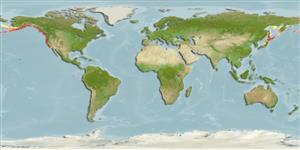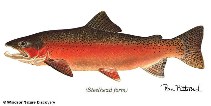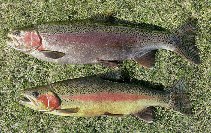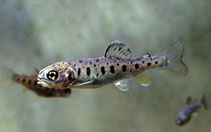Oncorhynchus mykiss (Walbaum, 1792)
Rainbow trout
把你的觀察加入 Fish Watcher
| Native range | All suitable habitat | Point map | Year 2050 |

|
| This map was computer-generated and has not yet been reviewed. |
| Oncorhynchus mykiss AquaMaps Data sources: GBIF OBIS |
Uzbekistan country information
Common names:
Rainbow trout
Occurrence: introduced
Salinity: freshwater
Abundance: | Ref:
Importance: commercial | Ref:
Aquaculture: commercial | Ref: FAO, 1997
Regulations: | Ref:
Uses: no uses
Comments: Recorded from Chirchik.
National Checklist:
Country Information: https://www.cia.gov/library/publications/resources/the-world-factbook/geos/uz.html
National Fisheries Authority:
Occurrences: Occurrences Point map
Main Ref: Kamilov, G. and Z.U. Urchinov, 1995
National Database:
Occurrence: introduced
Salinity: freshwater
Abundance: | Ref:
Importance: commercial | Ref:
Aquaculture: commercial | Ref: FAO, 1997
Regulations: | Ref:
Uses: no uses
Comments: Recorded from Chirchik.
National Checklist:
Country Information: https://www.cia.gov/library/publications/resources/the-world-factbook/geos/uz.html
National Fisheries Authority:
Occurrences: Occurrences Point map
Main Ref: Kamilov, G. and Z.U. Urchinov, 1995
National Database:
Common names from other countries
分類 / Names 俗名 | 同種異名 | Catalog of Fishes(屬, 種) | ITIS | CoL | WoRMS | Cloffa
Teleostei > Salmoniformes (Salmons) 鮭形目 (Salmons) > Salmonidae (Salmonids) 鮭科 (Salmonids) > Salmoninae
Etymology: Oncorhynchus: Greek, onyx, -ychos = nail + Greek, rhyngchos = snout (Ref. 45335); mykiss: Derived from the Kamchatkan name "mikizha" or "mykyz" (Ref. 10294).
More on author: Walbaum.
Etymology: Oncorhynchus: Greek, onyx, -ychos = nail + Greek, rhyngchos = snout (Ref. 45335); mykiss: Derived from the Kamchatkan name "mikizha" or "mykyz" (Ref. 10294).
More on author: Walbaum.
Environment: milieu / climate zone / depth range / distribution range 生態學
海洋; 淡水; 半鹹淡水 底中水層性; 溯河洄游 (Ref. 51243); 深度上下限 0 - 200 m (Ref. 50550). 溫帶; 10°C - 24°C (Ref. 12741); 67°N - 32°N, 135°E - 117°W
分布 國家 | FAO區域 | 生態系 | 發現紀錄 | Point map | 簡介 | Faunafri
Pacific Slope from Kuskokwim River drainage in Alaska to Otay River drainage in California, USA. Widely introduced and established in Canada and USA, including Arctic, Atlantic, Great Lakes, Mississippi River, and Rio Grande basins, and elsewhere in the world (Ref. 86798). Eastern Pacific: Kamchatkan Peninsula and have been recorded from the Commander Islands east of Kamchatka and sporadically in the Sea of Okhotsk as far south as the mouth of the Amur River along the mainland. The records outside Kamchatka probably represent migrating or straying Kamchatkan steelhead (penshinensis) rather than the established native population (Reg. 50080). Several countries report adverse ecological impact after introduction.
西南大西洋: 阿根廷.(參考文獻 9086) 東太平洋: 勘察加半島而且曾經記錄從指揮官島勘察加以東而且偶而在鄂霍次克海中向南遠至阿穆爾河河口沿著大陸。 勘察加以外的記錄可能代表移動或迷路勘察加鮭 ( penshinensis) 而不是確定的原生族群 (普通型的。 50080)。 一最,廣泛地被引入的魚種, 可能是視為全球的在它的存在分布中。 在熱帶中侷限於在 1,200 公尺上面的區域。 引入後的一些國家報告不利的生態衝擊.(參考文獻 5723)
西南大西洋: 阿根廷.(參考文獻 9086) 東太平洋: 勘察加半島而且曾經記錄從指揮官島勘察加以東而且偶而在鄂霍次克海中向南遠至阿穆爾河河口沿著大陸。 勘察加以外的記錄可能代表移動或迷路勘察加鮭 ( penshinensis) 而不是確定的原生族群 (普通型的。 50080)。 一最,廣泛地被引入的魚種, 可能是視為全球的在它的存在分布中。 在熱帶中侷限於在 1,200 公尺上面的區域。 引入後的一些國家報告不利的生態衝擊.(參考文獻 5723)
Length at first maturity / 大小 / 重量 / 年齡
Maturity: Lm ? range ? - ? cm
Max length : 122 cm TL 雄魚/尚未辨別雌雄; (Ref. 96339); common length : 60.0 cm TL 雄魚/尚未辨別雌雄; (Ref. 5504); 最大體重: 25.4 kg (Ref. 7251); 最大年齡: 11 年 (Ref. 12193)
Max length : 122 cm TL 雄魚/尚未辨別雌雄; (Ref. 96339); common length : 60.0 cm TL 雄魚/尚未辨別雌雄; (Ref. 5504); 最大體重: 25.4 kg (Ref. 7251); 最大年齡: 11 年 (Ref. 12193)
簡短描述 檢索表 | 型態特徵 | 形態測量圖
背棘 (總數) : 0; 背的軟條 (總數) : 14 - 16; 臀棘: 0; 臀鰭軟條: 6 - 12; 脊椎骨: 60 - 66. Diagnosis: Body elongate, somewhat compressed especially in larger fish. No nuptial tubercles but minor changes to head, mouth and color occur especially in spawning males. Colouration varies with habitat, size, and sexual condition; stream residents and spawners darker, colours more intense; lake residents lighter, brighter, and more silvery. Caudal fin with 19 rays (Ref. 2196). Differs from Oncorhynchus gorbuscha by having the following unique characters: anal fin with 6-9½ (usually 8½ ) branched rays; 115-130 scales in midlateral row; 16-17 gill rakers; breeding males lacking hump; juveniles lacking parr marks; wide pink to red stripe from head to caudal base, except in sea-run form; and juveniles with 5-10 parr marks (Ref. 59043).
細長的身體, 略微扁長形的尤其在較大的魚中。 沒有珠星但是較小的變成頭部,嘴與顏色尤其在生育期的雄魚中出現。 體色隨著棲息地,大小與性別狀態改變。 溪流魚種與產卵魚比較黑的, 顏色更密集。 湖泊魚種顏色淡的﹐比較明亮的﹐與更銀色的。 尾鰭有 19個鰭條。 (參考文獻 2196)
細長的身體, 略微扁長形的尤其在較大的魚中。 沒有珠星但是較小的變成頭部,嘴與顏色尤其在生育期的雄魚中出現。 體色隨著棲息地,大小與性別狀態改變。 溪流魚種與產卵魚比較黑的, 顏色更密集。 湖泊魚種顏色淡的﹐比較明亮的﹐與更銀色的。 尾鰭有 19個鰭條。 (參考文獻 2196)
Inhabit clear, cold headwaters, creeks, small to large rivers, lakes, and intertidal areas (Ref. 86798). Anadromous in coastal streams (Ref. 5723). Stocked in almost all water bodies as lakes, rivers and streams, usually not stocked in water reaching summer temperatures above 25°C or ponds with very low oxygen concentrations. Feed on a variety of aquatic and terrestrial invertebrates and small fishes. At the sea, they prey on fish and cephalopods. Mature individuals undertake short spawning migrations. Anadromous and lake forms may migrate long distances to spawning streams (Ref. 59043). Utilized fresh, smoked, canned, and frozen; eaten steamed, fried, broiled, boiled, microwaved and baked (Ref. 9988). Cultured in many countries and is often hatched and stocked into rivers and lakes especially to attract recreational fishers (Ref. 9988).
當較大的稚魚是大洋性的時候,小的稚魚是大洋底棲性魚種。 (參考文獻 58302) 此魚種的自然棲息地是淡水大約在夏天的 12 °C。 不清楚的是否它的由海洋移棲淡水產卵的習性是一個真實遺傳的適應或只是隨機的行為。 似乎任何的虹鱒品系能夠移動, 或至少適應海水, 如果需要或者機會發生。 他們需要和緩到快速的流動, 溶氧量高的水域繁殖, 但是他們也生活於寒冷的湖.(參考文獻 6390,44894) 虹鱒在湖中存活更多超過在溪流中.(參考文獻 26519) 從十一月到十月進入勘察加的河,在春天產卵,不遠離海洋, 而且迴游回到海洋五月- 六月時.(參考文獻 593) 通常接近底部覓食。 (參考文獻 13337) 成魚吃水生與陸棲的昆蟲,軟體動物,甲殼動物,魚卵,條魚類與其他的小魚;(包括其他的鱒魚) 幼魚主要以浮游動物為食。 (參考文獻 26523) 被煙燻,, 裝於罐頭與冷凍的生鮮使用; 清蒸,油炸,火烤, 煮沸, 微波.而且燒烤..(參考文獻 9988) 虹鱒在許多國家被養殖而且時常進入河川與湖泊之內孵化形成族群尤其吸引一般釣客。 (參考文獻 9988)
當較大的稚魚是大洋性的時候,小的稚魚是大洋底棲性魚種。 (參考文獻 58302) 此魚種的自然棲息地是淡水大約在夏天的 12 °C。 不清楚的是否它的由海洋移棲淡水產卵的習性是一個真實遺傳的適應或只是隨機的行為。 似乎任何的虹鱒品系能夠移動, 或至少適應海水, 如果需要或者機會發生。 他們需要和緩到快速的流動, 溶氧量高的水域繁殖, 但是他們也生活於寒冷的湖.(參考文獻 6390,44894) 虹鱒在湖中存活更多超過在溪流中.(參考文獻 26519) 從十一月到十月進入勘察加的河,在春天產卵,不遠離海洋, 而且迴游回到海洋五月- 六月時.(參考文獻 593) 通常接近底部覓食。 (參考文獻 13337) 成魚吃水生與陸棲的昆蟲,軟體動物,甲殼動物,魚卵,條魚類與其他的小魚;(包括其他的鱒魚) 幼魚主要以浮游動物為食。 (參考文獻 26523) 被煙燻,, 裝於罐頭與冷凍的生鮮使用; 清蒸,油炸,火烤, 煮沸, 微波.而且燒烤..(參考文獻 9988) 虹鱒在許多國家被養殖而且時常進入河川與湖泊之內孵化形成族群尤其吸引一般釣客。 (參考文獻 9988)
Life cycle and mating behavior 成熟度 | 繁殖 | 產卵場 | 卵 | 孕卵數 | 仔魚
Reported not to establish breeding populations if the peak emergence of fry corresponds to flood season and cold summer temperatures and if temperature does not fall below 13° C (Ref. 59043). Males mature generally at 2 years and females at 3. Spawning happens from November until May in the Northern hemisphere and from August to November on the Southern hemisphere. The size of the eggs depends on the size of the female. In captivity spawning is fostered by abdominal massage. Egg size 3-6 mm, fry length after hatching 12-20 mm. Hatchlings are well developed and equipped with a large yolk sac.
The female finds a spot and digs a pit. While digging, an attendant male courts her or is busy driving away other males. As soon as the pit is completed, the female drops into it and is immediately followed by the male. The pair is side by side, they open their mouth, quiver and release egg and sperm. Females produce from 700 to 4,000 eggs per spawning event (Ref. 4706). At this point, a subordinate male moves in and releases sperm into the nest. The female quickly moves to the upstream edge of the nest and starts digging a new pit, covering the eggs. The whole process is repeated for several days until the female deposits all her eggs (Ref. 27547). Young fish move downstream at night, shortly after emergence (Ref. 4706).
Reproductive strategy: synchronous ovarian organization, determinate fecundity (Ref. 51846).西南大西洋: 阿根廷.(參考文獻 9086) 東太平洋: 勘察加半島而且曾經記錄從指揮官島勘察加以東而且偶而在鄂霍次克海中向南遠至阿穆爾河河口沿著大陸。 勘察加以外的記錄可能代表移動或迷路勘察加鮭 ( penshinensis) 而不是確定的原生族群 (普通型的。 50080)。 一最,廣泛地被引入的魚種, 可能是視為全球的在它的存在分布中。 在熱帶中侷限於在 1,200 公尺上面的區域。 引入後的一些國家報告不利的生態衝擊.(參考文獻 5723)
主要參考資料
Upload your references | 參考文獻 | 合作者 | 合作者
Page, L.M. and B.M. Burr, 2011. A field guide to freshwater fishes of North America north of Mexico. Boston : Houghton Mifflin Harcourt, 663p. (Ref. 86798)
對人類具威脅
潛能有害之物
人類使用
漁業: 高經濟性; 養殖: 商業性; 游釣魚種: 是的
更多資訊
Population dynamics
成長參數
Max. ages / sizes
Length-weight rel.
Length-length rel.
長度-頻率
Mass conversion
入添量
豐度
成長參數
Max. ages / sizes
Length-weight rel.
Length-length rel.
長度-頻率
Mass conversion
入添量
豐度
Physiology
Body composition
Nutrients
耗氧量
游泳類型
游泳速度
Visual pigments
Fish sound
Diseases & Parasites
Toxicity (LC50s)
Body composition
Nutrients
耗氧量
游泳類型
游泳速度
Visual pigments
Fish sound
Diseases & Parasites
Toxicity (LC50s)
工具
Bio-Quiz | E-book | 野外調查 | 檢索表 | 長度- 頻率 Wizard | 生活- 歷史的工具 | 分布圖 | Classification Tree
| Catch-MSY |
特別的報告
下載 XML
網路資源
Alien/Invasive Species database | Aquatic Commons | BHL | Cloffa | BOLDSystems | Websites from users | 檢查 FishWatcher | CISTI | Catalog of Fishes(屬, 種) | DiscoverLife | DORIS | ECOTOX | Faunafri | Fishtrace | GenBank(基因組, 核甘) | GloBI | GOBASE | | Google Books | Google Scholar | Google | IGFA World Record | MitoFish | 國家資料庫 | Otolith Atlas of Taiwan Fishes | 公眾的水族館 | PubMed | Reef Life Survey | 魚類百科全書 | Scirus | SeaLifeBase | 樹狀分類階層 | Wikipedia(去, 搜尋) | World Records Freshwater Fishing | 動物學的記錄
Estimates based on models
Preferred temperature (Ref. 115969): 1.3 - 10, mean 5.4 (based on 315 cells).
Phylogenetic diversity index (Ref. 82804): PD50 = 0.5000 [Uniqueness, from 0.5 = low to 2.0 = high].
Bayesian length-weight: a=0.00933 (0.00731 - 0.01192), b=3.03 (2.98 - 3.08), in cm Total Length, based on LWR estimates for this species (Ref. 93245).
營養階層 (Ref. 69278): 4.1 ±0.3 se; based on diet studies.
回復力 (Ref. 120179): 中等的, 族群倍增時間最少 1.4 - 4.4年 (K=0.38-0.46; tm=2-5; tmax=11; Fec=200).
Fishing Vulnerability (Ref. 59153): Moderate vulnerability (43 of 100).
Climate Vulnerability (Ref. 125649): Moderate to high vulnerability (52 of 100).







